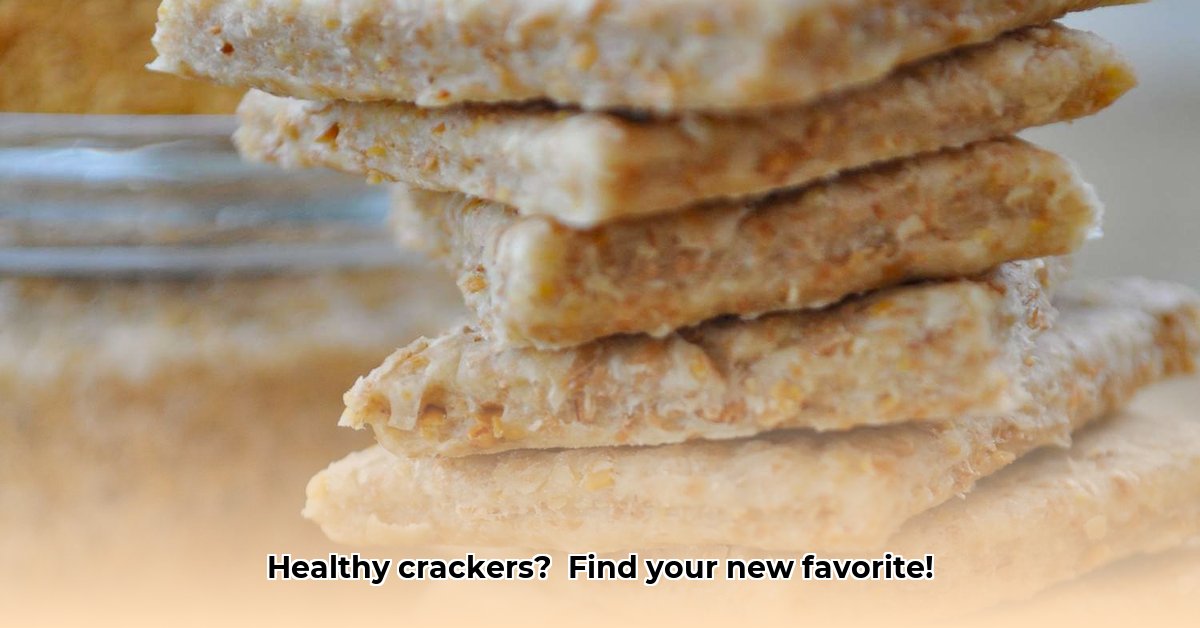Let’s be honest, the snack aisle can be overwhelming! Crackers, especially, seem to promise health but often deliver a whole lot of sodium and not much else. This guide is your shortcut to smarter snacking. We’ll show you exactly what to look for in a truly healthy cracker – think fiber, low sodium, and wholesome ingredients – and give you the inside scoop on some top-rated brands. We’ll even walk you through making your own delicious and healthy crackers at home. Get ready to ditch the confusing labels and discover crackers that are actually good for you!
Healthy Crackers: Your Guide to Guilt-Free Snacking
Let’s face it: the cracker aisle can be overwhelming. With so many brands boasting “healthy” claims, it’s tough to know which ones actually deliver. But don’t worry! This guide will help you navigate the options and find the perfect crunchy companion for your healthy lifestyle. We’ll uncover the secrets to choosing crackers that satisfy your cravings without sacrificing your health goals, ensuring nutritious snacking.
Decoding the Cracker Label: Unlocking the Nutritional Secrets
Reading a cracker label doesn’t have to feel like deciphering hieroglyphics. Let’s break down what truly matters to identify nutritious ingredients, control blood sugar, improve digestibility, and pick the best healthy cracker:
- Fiber: Your Digestive Superhero: Fiber is your friend! It keeps you feeling full, aids digestion, and contributes to overall well-being. Aim for crackers with at least 3 grams of fiber per serving. The more fiber, the better! Think of fiber as the secret ingredient for a happy tummy and sustained energy.
- Sodium: Keep it in Check: Excessive sodium contributes to high blood pressure, a serious health concern. Look for crackers with minimal added salt. The American Heart Association recommends no more than 2,300 milligrams of sodium per day for most adults. “Low sodium” is a good indicator, but always check the exact amount listed on the nutrition facts panel. Remember, small changes add up.
- Added Sugars: The Sneaky Culprit: Added sugars are often hidden in seemingly healthy foods and contribute to weight gain. Choose crackers without added sugars or with minimal amounts. Check the ingredient list because added sugars can hide under various names like corn syrup, dextrose, or sucrose. The Dietary Guidelines for Americans recommends limiting added sugars to less than 10% of your daily calories.
- Whole Grains: The Nutritional Powerhouses: Whole grains like whole wheat, brown rice, oats, and quinoa are packed with nutrients and fiber. They provide sustained energy and contribute to better digestion. Look for crackers where whole grains are listed as the first ingredient. The Whole Grains Council provides helpful information on identifying whole grain products.
- Ingredient Sleuthing: The Simpler, the Better: A short and simple ingredient list is a good sign. Avoid long lists with unpronounceable ingredients, artificial colors, preservatives, and unhealthy fats like partially hydrogenated oils (trans fats).
- Fats: Focus on Healthy Fats: While fat content shouldn’t be the sole determining factor, opt for crackers with healthy fats like those found in nuts and seeds (e.g., flaxseed, sunflower seeds, almonds). Avoid crackers with excessive amounts of saturated or trans fats.
A Taste Test: Top Healthy Cracker Considerations
When evaluating crackers, consider these points beyond just the nutritional label:
- Texture: Do you prefer a light and crispy cracker or something more substantial and hearty?
- Flavor: Are you looking for a neutral flavor that pairs well with toppings, or something with a distinct taste of its own?
- Ingredients Source: if you want to avoid all ingredients stripped of their nutrients, do your best to avoid refined oils, such as canola, soybean, and corn oil.
Level Up Your Snacking: Homemade Healthy Crackers
Want ultimate control over ingredients and flavor? Making your own crackers is surprisingly easy and rewarding! Discover the benefits of organic ingredients and low sodium alternatives.
Your Simple Homemade Cracker Recipe:
- Gather Your Ingredients: Combine 1 ½ cups whole wheat flour (or a gluten-free blend like almond flour), ½ cup rolled oats, ¼ cup mixed seeds (sunflower, flax, chia, sesame), 2 tablespoons olive oil (or avocado oil), and ½ teaspoon of sea salt in a large bowl.
- Create the Dough: Gradually add ¼ – ½ cup of water or unsweetened applesauce, mixing until a soft, pliable dough forms. You might need a little more or less liquid, depending on the flour you use. The dough should be slightly sticky but not overly wet.
- Add Flavor Boosters (Optional): Mix in herbs (rosemary, thyme), spices (garlic powder, onion powder, smoked paprika), or even a sprinkle of grated Parmesan cheese for extra flavor.
- Roll and Cut: Lightly flour a clean surface with gluten free flour for those who want it. Roll out the dough very thinly, about ⅛ inch thick. Use a pizza cutter or knife to cut the dough into desired shapes (squares, rectangles, circles).
- Bake to Perfection: Place crackers on a baking sheet lined with parchment paper. Dock the crackers with a fork (poke small holes) to prevent them from puffing up too much during baking. Bake at 350°F (175°C) for 10-15 minutes or until golden brown and crispy. Keep a close eye on them near the end of baking to prevent burning.
- Cool and Enjoy: Let the crackers cool completely on a wire rack before storing in an airtight container. They will crisp up further as they cool.
Serving Suggestions: Beyond Snacking
Crackers are incredibly versatile! Here are a few ideas to elevate your cracker game:
- Cheese and Charcuterie Boards: Pair your healthy crackers with a variety of cheeses, cured meats, fruits, and nuts for an elegant appetizer or snack board.
- Dips and Spreads: Enjoy them with hummus, guacamole, salsa, or your favorite bean dip.
- Soups and Salads: Add a crunchy element to your soups and salads by crumbling crackers on top.
- Travel-Friendly Snack: Pack them in your lunchbox for a convenient and satisfying snack on the go.
The Final Verdict: Finding Your Perfect Cracker
The “best” healthy cracker is subjective. Everyone’s dietary needs and preferences are unique. Prioritize what’s most important to you: high fiber, low sodium, gluten-free, or something else entirely. By understanding the key factors discussed and carefully reading the labels, you’ll be well-equipped to make informed choices and enjoy your guilt-free snacking experience. Remember, healthy snacking is a part of a balanced, holistic approach to good health.
How to Choose the Healthiest Gluten-Free Crackers
Key Takeaways:
- The gluten-free cracker market is booming, but navigating its options requires careful selection.
- Prioritize certified gluten-free labels to minimize cross-contamination risks. Look for the Certified Gluten-Free logo from the Gluten-Free Certification Organization (GFCO).
- Pay close attention to ingredient lists; fiber, sodium, and added sugar content vary widely, since a healthy immune system depends on limiting gluten intake.
- Consider your personal preferences for texture and flavor, as well as intended use (snacking, dipping, etc.).
- Homemade crackers offer greater control over ingredients and quality.
Decoding the Gluten-Free Cracker Label: What to Look For
So, you’re on a quest to find the healthiest gluten-free crackers. Where do you even begin? It’s a jungle out there! Let’s cut through the confusion. First, turn that package around and examine the nutrition label. What are we looking for to best improve gut health?
- Fiber: Aim for at least 3 grams of fiber per serving. Fiber helps keep you full, aids digestion, and contributes to overall gut health. More is generally better, up to a point.
- Sodium: Less is more! High sodium intake can contribute to high blood pressure. Look for crackers with less than 140mg per serving, ideally much less.
- Added Sugars: These offer empty calories. Choose crackers with minimal added sugar or none at all. Read the ingredient list carefully; sugar can hide under various names.
- Ingredients: Familiarize yourself with common gluten-free flours (rice, almond, cassava, quinoa, oat). Understand what they contribute, nutritionally speaking. Are there any ingredients you want to avoid? Are seeds (flax, chia, sesame) included for added nutrients? Look for a blend of flours for a more balanced nutritional profile.
- Oils: Be mindful of the oils used. Some gluten-free crackers may contain refined oils like canola or sunflower oil. Opt for crackers made with healthier oils like olive oil or avocado oil, or those that specify “expeller-pressed” oils.
Preparing Gluten-Free Crackers at Home: The Ultimate Control
Want complete control over ingredients and quality? Making your own crackers is surprisingly easy! The possibilities are endless. Consider experimenting with different gluten-free flours, spices, and seeds. You can customize them to your dietary needs and preferences. A simple recipe online (plenty are available!) will quickly get you started, using healthy substitutions to improve the health effects.
Tips for Gluten-Free Cracker Success:
- **Use a Blend
- The Best Bento Box Price For Your Perfect Packed Lunch - December 15, 2025
- Bento Box Shopping Tips for Smart and Stylish Lunch Prep - December 14, 2025
- Bento Box Trays Streamline Restaurant Meal Presentation and Transport - December 13, 2025










